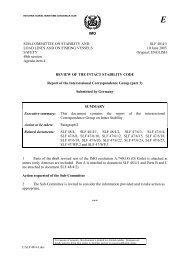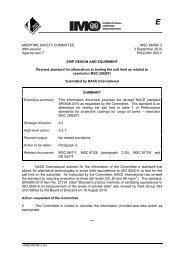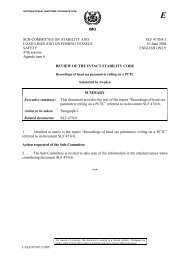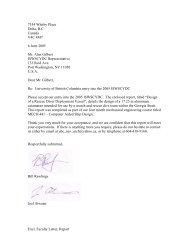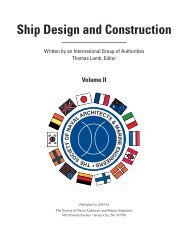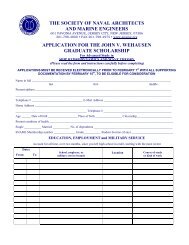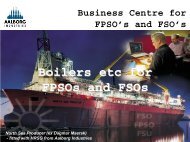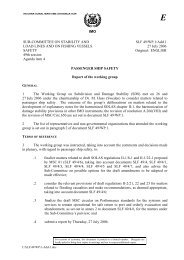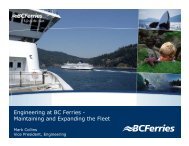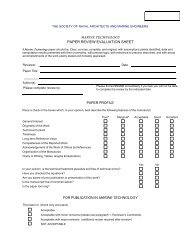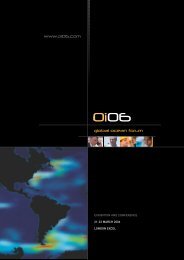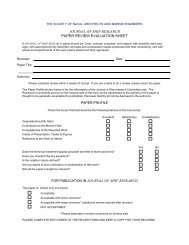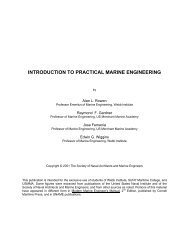new oil record book - SNAME.org
new oil record book - SNAME.org
new oil record book - SNAME.org
You also want an ePaper? Increase the reach of your titles
YUMPU automatically turns print PDFs into web optimized ePapers that Google loves.
FORM APPROVED<br />
OMB-1625-0009<br />
______________________<br />
OIL RECORD BOOK<br />
FOR SHIPS<br />
CHECK ONE:<br />
This <strong>book</strong> is for Machinery Space Operations (Part I-All Ships)<br />
This <strong>book</strong> is for Cargo/Ballast Operations (Part II-Oil Tankers)<br />
Name of Ship:<br />
Gross Tonnage:<br />
Owner:<br />
Period From: To: Official Number:<br />
THIS BOOK MUST BE MAINTAINED ABOARD THE SHIP FOR AT LEAST THREE YEARS<br />
FOLLOWING THE “TO” DATE LISTED ABOVE.<br />
This <strong>record</strong> <strong>book</strong> is issued by the Secretary of Homeland Security and is distributed by the United States Coast Guard<br />
to ships of American registry. It remains the property of the United States Government and each owner/operator is<br />
responsible to maintain and surrender it in accordance with the Secretary's regulations. Note that the Oil Record Book<br />
is o n e <strong>book</strong> with two parts; Machinery Space Operations is under Part I and Cargo/Ballast Operations is under Part II.<br />
An Oil Tanker of 150 gross tons or above must maintain Parts I and II of the Oil Record Book; Machinery Space<br />
Operations (Part I), and Cargo/Ballast Operations (Part II). A ship of 400 gross tons or above, other than an <strong>oil</strong> tanker,<br />
and any other ship required by 33 CFR Part 151 must maintain Machinery Space Operations (Part I) in the Oil Record<br />
Book.<br />
A non-tanker that carries more than 200 cubic meters of <strong>oil</strong> must fill in the Oil Record Book used for <strong>oil</strong> tankers.<br />
(Reference: MARPOL 73/78, Regulation 2(2)).<br />
An agency may not conduct or sponsor, and a person is not required to respond to a collection of information unless it displays a valid OMB control<br />
number. The Coast Guard estimates that the average burden for this report is 2.5 minutes. You may submit comments concerning the accuracy of<br />
this burden estimate or any suggestions for reducing the burden to COMDT (G-MOC), U.S. Coast Guard, Washington, DC 20593-0001 or Office of<br />
Management and Budget, Paperwork Reduction Project (2115-0526), Washington, DC 20503.<br />
DEPT. OF HOMELAND SECURITY, USCG, CG-4602A (Rev. 04-05)<br />
SN 7530-01-GF3-0660
Extract of MARPOL 73/78 Regulations<br />
MARPOL 73/78 Annex I: Chapter II, Regulation 9<br />
(1) Subject to the provisions of Regulations 10 and 11 of this Annex and paragraph (2) of this Regulation, any<br />
discharge into the sea of <strong>oil</strong> or <strong>oil</strong>y mixtures from ships to which this Annex applies shall be prohibited except when<br />
all the following conditions are satisfied: 1<br />
(a) for an <strong>oil</strong> tanker, except as provided for in sub-paragraph (b) of his paragraph:<br />
(i) the tanker is not within a special area;<br />
(ii) the tanker is more than 50 nautical miles from the nearest land;<br />
(iii) the tanker is proceeding en route;<br />
(iv) the instantaneous rate of discharge of <strong>oil</strong> content does not exceed 30 litres per nautical mile;<br />
(v) the total quantity of <strong>oil</strong> discharged into the sea does not exceed for existing tankers 1/15,000 of the<br />
total quantity of the particular cargo of which the residue formed a part, and for <strong>new</strong> tankers 1/30,000 of the<br />
total quantity of the particular cargo of which the residue formed a part; and<br />
(vi) the tanker has in operation, an <strong>oil</strong> discharge monitoring and control system and a slop tank arrangement as<br />
required by Regulation 15 of this Annex; 2<br />
(b) from a ship of 400 tons gross tonnage and above other than an <strong>oil</strong> tanker and from machinery space<br />
bilges excluding cargo pump room bilges of an <strong>oil</strong> tanker unless mixed with <strong>oil</strong> cargo residue:<br />
(i) the ship is not within a special area;<br />
(ii) the ship is proceeding en route;<br />
(iii) the <strong>oil</strong> content of the effluent without dilution does not exceed 15 parts per million;<br />
(iv) the ship has in operation equipment as required by Regulation 16 of this Annex. 3<br />
NOTES:<br />
1 Regulation 10 is titled "Methods for the Prevention of Oil Pollution from Ships while operating in<br />
Special Areas."<br />
Regulation 11 is titled "Exceptions."<br />
2 Regulation 15 is titled "Retention of Oil on Board."<br />
3 Regulation 16 is titled "Oil Discharge Monitoring and Control System and Oil Filtering Equipment."<br />
1
OIL RECORD BOOK ENTRY REQUIREMENTS<br />
MARPOL 73/78 Annex I: Chapter II, Regulation 20<br />
(1) Every <strong>oil</strong> tanker of 150 tons gross tonnage and above and every ship of 400 gross tons and above other than an <strong>oil</strong><br />
tanker shall be provided with an Oil Record Book Part I (Machinery Space Operations). Every <strong>oil</strong> tanker of 150 tons<br />
gross tonnage and above shall also be provided with an Oil Record Book Part II (Cargo/Ballast Operations). The Oil<br />
Record Book(s), whether as a part of the ship's official log <strong>book</strong> or otherwise, shall be in the Form(s) specified in<br />
Appendix III to this Annex.<br />
(2) The Oil Record Book shall be completed on each occasion, on a tank to tank basis if appropriate, whenever any of<br />
the following operations take place in the ship:<br />
(a) for machinery space operations (all ships):<br />
(i) ballasting or cleaning of <strong>oil</strong> fuel tanks;<br />
(ii) discharge of dirty ballast or cleaning water from tanks referred to under (i) of the sub-paragraph;<br />
(iii) disposal of <strong>oil</strong>y residues (sludge);<br />
(iv) discharge overboard or disposal otherwise of bilge water which has accumulated in machinery spaces;<br />
(b) for cargo/ballast operations (<strong>oil</strong> tankers):<br />
(i) loading of <strong>oil</strong> cargo;<br />
(ii) internal transfer of <strong>oil</strong> cargo during voyage;<br />
(iii) unloading of <strong>oil</strong> cargo;<br />
(iv) ballasting of cargo tanks and dedicated clean ballast tanks;<br />
(v) cleaning of cargo tanks including crude <strong>oil</strong> washing;<br />
(vi) discharge of ballast except from segregated ballast tanks;<br />
(vii) discharge of water from slop tanks;<br />
(viii) closing of all applicable valves or similar devices after slop tank discharge operations;<br />
(ix) closing of valves necessary for isolation of dedicated clean ballast tanks from cargo and stripping lines<br />
after slop tank discharge operations;<br />
(x) disposal of residues.<br />
(3) In the event of such discharge of <strong>oil</strong> or <strong>oil</strong>y mixture as is referred to in Regulation 11 of this Annex or in the event of<br />
accidental or other exceptional discharge of <strong>oil</strong> not excepted by that Regulation, a statement shall be made in the Oil<br />
Record Book of the circumstances of, and the reasons for, the discharge.<br />
(4) Each operation described in paragraph (2) of this Regulation shall be fully <strong>record</strong>ed without delay in the Oil Record<br />
Book so that all the entries in the <strong>book</strong> appropriate to that operation are completed. Each completed operation shall<br />
be signed by the officer or officers in charge of the operations concerned and each completed page shall be signed by<br />
the master of the ship. The entries in the Oil Record Book shall be in an official language of the State whose flag the<br />
ship is entitled to fly, and, for ships holding an International Oil Pollution Prevention Certificate, in English or French.<br />
The entries in an official national language of the State whose flag the ship is entitled to fly shall prevail in case of a<br />
dispute or discrepancy.<br />
(5) The Oil Record Book shall be kept in such a place as to be readily available for inspection at all reasonable times<br />
and, except in the case of unmanned ships under tow, shall be kept on board the ship. It shall be preserved on board<br />
the ship for a period of three years after the last entry has been made.<br />
(6) The competent authority of the Government of a Party to the Convention may inspect the Oil Record Book on<br />
board any ship to which this Annex applies while the ship is in its port or offshore terminals and may make a copy of<br />
any entry in that <strong>book</strong> and may require the Master of the ship to certify that the copy is a true copy of such entry. Any<br />
copy so made which has been certified by the Master of the ship as a true copy of an entry in the ship's Oil Record<br />
Book shall be made admissible in any judicial proceedings as evidence of the facts stated in the entry. The inspection<br />
of an Oil Record Book and the taking of a certified copy by the competent authority under this paragraph shall be<br />
performed as expeditiously as possible without causing the ship to be unduly delayed.<br />
2
OIL RECORD BOOK PART I-MACHINERY SPACE<br />
OPERATIONS<br />
INSTRUCTIONS FOR ALL SHIPS*<br />
The following pages of this section show a comprehensive list of items of machinery space operations which are, when<br />
appropriate, to be <strong>record</strong>ed in the Oil Record Book in accordance with Regulation 20 of Annex I of the International<br />
Convention for the Prevention of Pollution from Ships, 1973, as modified by the Protocol of 1978 relating thereto<br />
(MARPOL 73/78). The items are grouped into operational sections, each of which is denoted by a letter code.<br />
ENTRIES<br />
When making entries in the Oil Record Book, the date, operation code and item number shall be inserted in the<br />
appropriate columns and the required particulars shall be <strong>record</strong>ed chronologically in the blank spaces.<br />
SIGNATURES<br />
Each completed operation shall be signed for and dated by the officer or officers in charge. Each completed page<br />
shall be signed by the master of the ship.<br />
QUANTITIES<br />
The Oil Record Book contains many references to <strong>oil</strong> quantity. The limited accuracy of tank measurement devices,<br />
temperature variations and clingage will affect the accuracy of these readings. The entries in the Oil Record Book<br />
should be considered accordingly.<br />
All quantities should be consistently <strong>record</strong>ed throughout the Oil Record Book as cubic meters, gallons, or barrels.<br />
*NOTE: Oil Record Book Part I is provided to every <strong>oil</strong> tanker of 150 tons gross tonnage<br />
and above and every ship of 400 tons gross tonnage and above, other than <strong>oil</strong> tankers, to<br />
<strong>record</strong> relevant machinery space operations. For <strong>oil</strong> tankers, Oil Record Book Part II is<br />
also provided to <strong>record</strong> relevant cargo/ballast operations.<br />
CODE AND ITEM NUMBER TO BE RECORDED FOR ALL<br />
SHIPS 400 GROSS TONS AND ABOVE<br />
(A) BALLASTING OR CLEANING OF OIL FUEL TANKS<br />
1. Identity of tank(s) ballasted.<br />
2. Whether cleaned since they last contained <strong>oil</strong> and, if not, type of <strong>oil</strong> previously carried.<br />
3. Cleaning process:<br />
.1 Position of ship and time at start and completion of cleaning;<br />
.2 Identify tank(s) in which one or another method has been employed (rinsing through, steaming, cleaning<br />
with chemicals; type and quantity of chemicals used);<br />
.3 Identify tank(s) into which cleaning water was transferred.<br />
4. Ballasting:<br />
.1 Position of ship and time at start and end of ballasting;<br />
.2 Quantity of ballast if tanks are not cleaned;<br />
(B) DISCHARGE OF DIRTY BALLAST OR CLEANING WATER FROM OIL FUEL TANKS REFERRED<br />
TO UNDER SECTION (A)<br />
5. Identity of tank(s).<br />
6. Position of ship at start of discharge.<br />
7. Position of ship on completion of discharge.<br />
8. Ship’s speed(s) during discharge.<br />
9. Method of discharge:<br />
.1 Through 15 PPM equipment;<br />
.2 To reception facility.<br />
10. Quantity discharged.<br />
3
(C) COLLECTION AND DISPOSAL OF OIL RESIDUES (SLUDGE)<br />
11. Collection of <strong>oil</strong> residues<br />
Quantity of <strong>oil</strong> residues (sludge) retained on board at the end of a voyage, but not more frequently than once<br />
a week. When ships are on short voyages, the quantity should be <strong>record</strong>ed weekly. 1<br />
.1 Separated sludge (sludge resulting from purification of fuel and lubricating <strong>oil</strong>s) and other residues, if<br />
applicable:<br />
- identity of tank(s)..................................<br />
- capacity of tank(s)................................ m 3<br />
- total quantity of retention ..................... m 3<br />
.2 Other residues (such as <strong>oil</strong> residues resulting from drainages, leakages, exhausted <strong>oil</strong>,<br />
etc., in the machinery spaces), if applicable due to tank arrangement in addition to .1:<br />
- identity of tank(s)..................................<br />
- capacity of tank(s)................................ m 3<br />
- total quantity of retention ..................... m 3<br />
12. Methods of disposal of residue:<br />
State quantity of <strong>oil</strong> residues disposed of, the tank(s) emptied and the quantity of the<br />
contents retained:<br />
.1 To reception facilities (identify port); 2<br />
.2 Transferred to another (other) tank(s) (indicate tank(s) and the total content of tank(s));<br />
.3 Incinerated (indicate total time of operation);<br />
.4 Other method (state which).<br />
(D) NON-AUTOMATIC DISCHARGE OVERBOARD OR DISPOSAL OTHERWISE OF BILGE WATER<br />
WHICH HAS ACCUMULATED IN MACHINERY SPACES<br />
13. Quantity discharged or disposed of.<br />
14. Time of discharge or disposal (start and stop).<br />
15. Method of discharge or disposal:<br />
.1 Through 15 PPM equipment (state position at start and end);<br />
.2 To reception facilities (identify port); 2<br />
.3 Transfer to slop or holding tank (indicate tank(s); state quantity transferred and the<br />
total quantity retained in tanks(s)).<br />
(E) AUTOMATIC DISCHARGE OVERBOARD OR DISPOSAL OTHERWISE OF BILGE WATER WHICH<br />
HAS ACCUMULATED IN MACHINERY SPACES<br />
16. Time and position of ship at which the system has been put into automatic mode of<br />
operation for discharge overboard.<br />
17. Time when the system has been put into automatic mode of operation for transfer of bilge water to holding<br />
tank (identify tank).<br />
18. Time when the system has been put to manual operation.<br />
19. Method of discharge overboard:<br />
.1 Through 15 PPM equipment.<br />
NOTES:<br />
1 Only in tanks listed in item 3 of Form A and B of the Supplement to the IOPP Certificate.<br />
2<br />
Ships' master should obtain from the operator of the reception facilities which include<br />
barges and tank trucks a receipt or certificate detailing the quantity of tank washings, dirty<br />
ballast, residues or <strong>oil</strong>y mixtures transferred, together with the time and date of the transfer.<br />
This receipt or certificate, if attached to the Oil Record Book, may aid the master of the ship<br />
in proving that the ship was not involved in an alleged pollution incident. This receipt or<br />
certificate should be kept together with the Oil Record Book.<br />
4
(F) CONDITION OF OIL DISCHARGE MONITORING AND CONTROL SYSTEM<br />
20. Time of system failure.<br />
21. Time when system has been made operational.<br />
22. Reasons for failure.<br />
(G) ACCIDENTAL OR OTHER EXCEPTIONAL DISCHARGES OF OIL<br />
23. Time of occurrence.<br />
24. Place or position of ship at time of occurrence.<br />
25. Approximate quantity and type of <strong>oil</strong>.<br />
26. Circumstances of discharge or escape, the reasons therefore and general remarks.<br />
(H) BUNKERING OF FUEL OR BULK LUBRICATING OIL<br />
27. Bunkering<br />
.1 Place of bunkering;<br />
.2 Time of bunkering;<br />
.3 Type and quantity of fuel <strong>oil</strong> and identity of tank(s) (state quantity added and total<br />
total content of tank(s)).<br />
.4 Type and quantity of lubricating <strong>oil</strong> and identity of tank(s) (state quantity added and<br />
total content of tank(s)).<br />
(I) ADDITIONAL OPERATIONAL PROCEDURES AND GENERAL REMARKS<br />
5
EXAMPLES<br />
Name of Ship<br />
Official Number<br />
CARGO/BALLAST OPERATIONS (Oil Tanker) /<br />
M/V NOT AN OIL TANKER<br />
413567_________________<br />
MACHINERY SPACE OPERATIONS<br />
Date Code Item Record of Operations/signature of officers in charge<br />
EXAMPLE: BALLASTING/CLEANING FUEL TANKS<br />
10/07/2005 A 1 No. 5 DB Port and Stbd<br />
A 2 Yes<br />
A 3.1 49°56’ N x 30°00’W - Start 1605<br />
50°00’ N x 29°58’W – Stop 1730<br />
A 3.2 No. 5 DB Port and Stbd, Rinsing through<br />
A 3.3 Collecting tank<br />
A 4.1 Start ballast 50°00’ N x 29°58’W at<br />
1730<br />
End ballast 50°04’ N x 29°56’W at<br />
2357<br />
J. Brennan<br />
10/11/2005 C 11.1<br />
EXAMPLE: VOYAGE/WEEKLY SLUDGE REPORT<br />
Max. Cap R.O.B<br />
Sludge Tank #6 67.4m 3<br />
21.7m 3<br />
Sludge Tank #12 5 m 3<br />
4.4m 3<br />
Total Retained on Board<br />
26.1m 3<br />
M.A. Carroll<br />
EXAMPLE: SLUDGE REPORT<br />
11/10/2005 C 12.1 Providence, RI- Landed 3 drums with<br />
a total of .5m 3 Sludge from manual tank<br />
cleaning of #4 Collection tank.<br />
R.O.B 00.00 m 3<br />
M. Walter<br />
_John Cate_______<br />
Signature of Master<br />
6
EXAMPLES<br />
Name of Ship<br />
Official Number<br />
CARGO/BALLAST OPERATIONS (Oil Tanker) /<br />
M/V NOT AN OIL TANKER<br />
413567_________________<br />
MACHINERY SPACE OPERATIONS<br />
Date Code Item Record of Operations/signature of officers in charge<br />
EXAMPLE: BILGE WATER DISPOSAL # 1<br />
05/06/2005 D 13 14 m 3 bilge water<br />
D 14 Start 1000 - Stop 1200<br />
D 15.3 To collecting tank, 14 m 3 transferred,<br />
30 m 3 retained in tank.<br />
Z.L. Hughes<br />
EXAMPLE: BILGE WATER DISPOSAL # 2<br />
05/06/2005 D 13 14 m 3 bilge water<br />
D 14 Start 0000- Stop 0300<br />
D 15.1 50°00’ N x 29°58’W - Start<br />
49°56’ N x 30°00’W - Stop<br />
K. Brennan<br />
EXAMPLE: FAILURE OF MONITORING/CONTROL<br />
05/06/2005 F 20 Stop due to failure 1000<br />
F 21 Item repaired, Started 1130<br />
F 22 Recirculation valve opening prematurely,<br />
Cleaned lens; all in apparent good<br />
order.<br />
L. Kowalz<br />
EXAMPLE: BUNKERING<br />
05/17/2005 H 27.1 Boston, Mass. USA<br />
H 27.2 Start 0910 - Stop 1235<br />
H 27.3 Bunkered 600 m 3 Fuel <strong>oil</strong> IFO 380 as<br />
follows:<br />
F.O. Tank #4 Added 50m 3 R.O.B. 220 m 3<br />
F.O. Tank #5 Added 210m 3 R.O.B. 230 m<br />
_John Cate________<br />
Signature of Master<br />
3<br />
F.O. Tank #6 Added 34m 3 R.O.B. 402 m 3<br />
M. Broughton<br />
7
OIL RECORD BOOK PART II-CARGO/BALLAST<br />
OPERATIONS<br />
ADDITIONAL INSTRUCTIONS FOR OIL TANKERS*<br />
The following pages of this section show a comprehensive list of items of cargo and ballast operations which are,<br />
when appropriate, to be <strong>record</strong>ed in the Oil Record Book in accordance with Regulation 20 of Annex I of the<br />
International Convention for the Prevention of Pollution from Ships, 1973, as modified by the Protocol of 1978 relating<br />
thereto (MARPOL 73/78). The items are grouped into operational sections, each of which is denoted by a letter.<br />
ENTRIES<br />
When making entries in the Oil Record Book, the date, operation code and item number shall be inserted in the<br />
appropriate columns and the required particulars shall be <strong>record</strong>ed chronologically in the blank spaces.<br />
SIGNATURES<br />
Each completed operation shall be signed for and dated by the officer or officers in charge. Each completed page shall<br />
be signed by the master of the ship. In respect of the <strong>oil</strong> tankers engaged in specific trades in accordance with<br />
Regulation 13C of Annex I of MARPOL 73/78, appropriate entry in the Oil Record Book shall be endorsed by<br />
competent Port State authority.<br />
QUANTITIES<br />
The Oil Record Book contains many references to <strong>oil</strong> quantity. The limited accuracy of tank measurement devices,<br />
temperature variations and clingage will affect the accuracy of these readings. The entries in the Oil Record Book<br />
should be considered accordingly.<br />
All quantities should be consistently <strong>record</strong>ed throughout the Oil Record Book as cubic meters, gallons, or barrels.<br />
*NOTE: Every <strong>oil</strong> tanker of 150 tons gross tonnage and above shall be provided with Oil<br />
Record Book Part II to <strong>record</strong> relevant cargo/ballast operations. Such a tanker is also<br />
provided with Oil Record Book Part I to <strong>record</strong> relevant machinery space operations.<br />
CODE AND ITEM NUMBER TO BE RECORDED FOR TANKERS<br />
(A) LOADING OF OIL CARGO<br />
1. Place of loading.<br />
2. Type of <strong>oil</strong> loaded and identity of tank(s).<br />
3. Total quantity of <strong>oil</strong> loaded (state quantity added and the total content of tank(s)).<br />
(B) INTERNAL TRANSFER OF OIL CARGO DURING VOYAGE<br />
4. Identity of tank(s)<br />
.1 From:<br />
.2 To: (state quantity transferred and total quantity of tank(s)).<br />
5. Was (were) tank(s) in 4.1 emptied? (If not, state the quantity retained).<br />
(C) UNLOADING OF OIL CARGO<br />
6. Place of unloading.<br />
7. Identity of tank(s) unloaded.<br />
8. Was (were) tank(s) emptied? (If not, state quantity retained).<br />
8
(D) CRUDE OIL WASHING (COW TANKERS ONLY)<br />
(To be completed for each tank being crude <strong>oil</strong> washed)<br />
9. Port where crude <strong>oil</strong> washing is carried out or ship's position if carried out between two<br />
discharge ports.<br />
10. Identity of tank(s) washed. 1<br />
11. Number of machines in use.<br />
12. Time of start of washing.<br />
13. Washing pattern employed. 2<br />
14. Washing line pressure.<br />
15. Time completed or stopped washing.<br />
16. State method of establishing that tank(s) was (were) dry.<br />
17. Remarks. 3<br />
(E) BALLASTING OF CARGO TANKS<br />
18. Position of ship at start and end of ballasting.<br />
19. Ballasting process:<br />
.1 Identity of tank(s) ballasted;<br />
.2 Time of start and end;<br />
.3 Quantity of ballast received. Indicate total quantity of ballast for each tank involved<br />
in the operation.<br />
(F) BALLASTING OF DEDICATED CLEAN BALLAST TANKS (CBT TANKERS ONLY)<br />
20. Identity of tank(s) ballasted.<br />
21. Position of ship when water intended for flushing, or port ballast is taken into dedicated<br />
clean ballast tank(s).<br />
22. Position of ship when pump(s) and lines are flushed to slop tank.<br />
23. Quantity of <strong>oil</strong>y water which, after line flushing, is transferred to the slop tank(s) or cargo<br />
tank(s) in which slop is preliminarily stored (identify tank(s)). State the total quantity.<br />
24. Position of ship when additional ballast water is taken into dedicated clean ballast tank(s)<br />
25. Time and position of ship when valves separating the dedicated clean ballast tanks from<br />
cargo and stripping lines were closed.<br />
26. Quantity of clean ballast taken on board.<br />
(G) CLEANING OF CARGO TANKS<br />
27. Identity of tank(s) cleaned.<br />
28. Port or ship's position.<br />
29. Duration of cleaning.<br />
30. Method of cleaning. 4<br />
31. Tank washings transferred to:<br />
.1 Reception facilities (state port and quantity); 5<br />
.2 Slop tank(s) or cargo tank(s) designated as slop tank(s) (Identity of tank(s); state<br />
quantity transferred and total quantity).<br />
NOTES:<br />
1 When an individual tank has more machines than can be operated simultaneously, as described in the Operations<br />
and Equipment Manual, then the section being crude <strong>oil</strong> washed should be identified, e.g. No. 2 center, forward<br />
section.<br />
2 In accordance with the Operations and Equipment Manual, enter whether single-stage or multi-stage method of<br />
washing is employed. If multi-stage method is used, give the vertical arc covered by the machines and the number<br />
of times that arc is covered for that particular stage of the program.<br />
3 If the methods given in the Operations and Equipment Manual are not followed, give the reasons under Remarks.<br />
4 This includes hand hosing, machine washing and/or chemical cleaning. Where chemically cleaned, state the<br />
chemical concerned and amount used.<br />
5 Ships' masters should obtain from the operator of the reception facilities which include barges and tank trucks a<br />
receipt or certificate detailing the quantity of tank washings, dirty ballast, residues or <strong>oil</strong>y mixtures transferred,<br />
together with the time and date of the transfer. This receipt or certificate, if attached to the Oil Record Book, may<br />
aid the master of the ship in proving that this ship was not involved in an alleged pollution incident. The receipt or<br />
certificate should be kept together with the Oil Record Book.<br />
9
(H) DISCHARGE OF DIRTY BALLAST<br />
32. Identity of tank(s).<br />
33. Position of ship at start of discharge into the sea.<br />
34. Position of ship on completion of discharge into the sea.<br />
35. Quantity discharged into the sea.<br />
36. Ship's speed(s) during discharge.<br />
37. Was the discharge monitoring and control system in operation during the discharge?<br />
38. Was a regular check kept on the effluent and the surface of the water in the locality of<br />
the discharge?<br />
39. Quantity of <strong>oil</strong>y water transferred to slop tank(s) (identify slop tank (s); state total<br />
quantity).<br />
40. Discharge to shore reception facilities (identify port and quantity<br />
involved). 5<br />
(I) DISCHARGE OF WATER FROM SLOP TANKS INTO THE SEA<br />
41. Identify slop tank(s).<br />
42. Time of settling from last entry of residues, or,<br />
43. Time of settling from last discharge.<br />
44. Time and position of ship at start of discharge.<br />
45. Ullage of total contents at start of discharge.<br />
46. Ullage of <strong>oil</strong>/water interface at start of discharge.<br />
47. Bulk quantity discharged and rate of discharge (amount discharged using the main cargo pump).<br />
48. Final quantity discharged and rate of discharge (amount discharged using the stripping pump).<br />
49. Time and position of ship on completion of discharge.<br />
50. Was the discharge monitoring and control system in operation during the<br />
discharge?<br />
51. Ullage of <strong>oil</strong>/water interface on completion of discharge.<br />
52. Ship's speed(s) during discharge.<br />
53. Was a regular check kept on the effluent and the surface of the water in the<br />
locality of the discharge?<br />
54. Confirm that all applicable valves in the ship's piping system have been closed<br />
on completion of discharge from the slop tanks.<br />
(J) DISPOSAL OF RESIDUES AND OILY MIXTURES NOT OTHERWISE DEALT WITH<br />
55. Identity of tank(s).<br />
56. Quantity disposed of from each tank. (State the quantity retained).<br />
57. Method of disposal:<br />
.1 To reception facilities (identify port and quantity involved); 5<br />
.2 Mixed with cargo (State quantity);<br />
.3 Transferred to (an)other tank(s) (identify tank(s)); state quantity transferred<br />
and total quantity in tank(s);<br />
.4 Other method (state which); state quantity disposed of.<br />
NOTES:<br />
5 Ships' masters should obtain from the operator of the reception facilities which include barges<br />
and tank trucks a receipt or certificate detailing the quantity of tank washings, dirty ballast,<br />
residues or <strong>oil</strong>y mixtures transferred, together with the time and date of the transfer. This receipt<br />
or certificate, if attached to the Oil Record Book, may aid the master of the ship in proving that<br />
this ship was not involved in an alleged pollution incident. The receipt or certificate should be<br />
kept together with the Oil Record Book.<br />
10
(K) DISCHARGE OF CLEAN BALLAST CONTAINED IN CARGO TANKS<br />
58. Position of Ship at start of discharge of clean ballast.<br />
59. Identity of tank(s) discharged.<br />
60. Was (were) the tank(s) empty on completion?<br />
61. Position of ship on completion if different from 58.<br />
62. Was a regular check kept on the effluent and the surface of the water in the locality of the<br />
discharge?<br />
(L) DISCHARGE OF BALLAST FROM DEDICATED CLEAN BALLAST TANKS (CBT TANKERS ONLY)<br />
63. Identity of tank(s) discharged.<br />
64. Time and position of ship at start discharge of clean ballast into the sea.<br />
65. Time and position of ship on completion of discharge into the sea.<br />
66. Quantity discharged:<br />
.1 Into the sea; or<br />
.2 To reception facility (identify port).<br />
67. Was there any indication of <strong>oil</strong> contamination of the ballast water before or<br />
during the discharge into the sea?<br />
68. Was the discharge monitored by an <strong>oil</strong> content meter?<br />
69. Time and position of ship when valves separating dedicated clean ballast tanks from<br />
the cargo and stripping lines were closed on completion of deballasting.<br />
(M) CONDITION OF OIL DISCHARGE MONITORING AND CONTROL SYSTEM<br />
70. Time of system failure.<br />
71. Time when system has been made operational.<br />
72. Reasons for failure.<br />
(N) ACCIDENTAL OR OTHER EXCEPTIONAL DISCHARGES OF OIL<br />
73. Time of occurrence.<br />
74. Port or ship’s position at time of occurrence.<br />
75. Approximate quantity and type of <strong>oil</strong>.<br />
76. Circumstances of discharge or escape, the reasons therefore and general remarks.<br />
(O) ADDITIONAL OPERATIONAL PROCEDURES AND GENERAL REMARKS<br />
ADDITIONAL CODES FOR TANKERS ENGAGED IN SPECIFIC TRADES<br />
(P) LOADING OF BALLAST WATER<br />
77. Identity of tank(s) ballasted.<br />
78. Position of ship when ballasted.<br />
79. Total quantity of ballast loaded in cubic meters.<br />
80. Remarks.<br />
(Q) REALLOCATION OF BALLAST WATER WITHIN THE SHIP<br />
81. Reasons for reallocation.<br />
(R) BALLAST WATER DISCHARGE TO RECEPTION FACILITY<br />
82. Port(s) where ballast water was discharged.<br />
83. Name or designation of reception facility.<br />
84. Total quantity of ballast water discharged in cubic meters.<br />
85. Date, signature and stamp of port authority official.<br />
11
EXAMPLES<br />
Name of Ship<br />
Official Number<br />
CARGO/BALLAST OPERATIONS<br />
M/V OIL TANKER<br />
703393_________<br />
/ MACHINERY SPACE OPERATIONS (All Ships)<br />
Date Code Item Record of Operations/signature of officers in charge<br />
EXAMPLE: LOADING CARGO<br />
3/2/2005 A 1 Port Shaw, California<br />
A 2 Heavy fuel <strong>oil</strong> 1-5 C, 1-5 STBD, and 1-5<br />
P<br />
A 3 238 m 3 loaded, 1010 m 3 Total aboard.<br />
N. Ely<br />
EXAMPLE: INTERNAL TRANSFER OF CARGO<br />
3/4/2005 B 4.1 2C<br />
B 4.2 5C 70 m 3 transferred, 127m 3<br />
total quantity.<br />
B 5 No, 158 m 3 retained in 2C<br />
S. Williams<br />
EXAMPLE: UNLOADING CARGO<br />
3/8/2005 C 6 Port Pine ,Texas<br />
C 7 1C, 3C, and 5C<br />
C 8 Yes<br />
T. Colton<br />
3/17/2005 EXAMPLE: BALLASTING CLEAN BALLAST TKS<br />
F 20 #3 Port<br />
F 21 49°56’ N x 30°00’W<br />
F 22 49°54’ N x 30°00’W<br />
F 23 77 m 3<br />
F 24 49°53’ N x 30°00’W<br />
F 25 49°52’ N x 29°58’W – 1730<br />
F 26 200 m 3<br />
Thomas Carroll________<br />
Signature of Master<br />
S. Keep<br />
EXAMPLES<br />
12
Name of Ship<br />
Official Number<br />
CARGO/BALLAST OPERATIONS<br />
M/V OIL TANKER<br />
703393_________<br />
/ MACHINERY SPACE OPERATIONS (All Ships)<br />
Date Code Item Record of Operations/signature of officers in charge<br />
EXAMPLE: CLEANING CARGO TANKS<br />
3/29/2005 G 27 No. 5 port<br />
G 28 Rodeo, California<br />
G 29 3 Hours (1300-1600)<br />
G 30 Machine wash<br />
G 31.2 No. 1 Slop Tank, 7.9 m 3 transferred,<br />
87 m 3 total.<br />
S. Bliss<br />
EXAMPLE: DISCHARGE OF WATER FROM SLOP<br />
3/29/2005 I 41 No. 2 Slop Tank<br />
I 42 36 Hours<br />
I 44 1330 49°52’ N x 29°58’W<br />
I 45 7 feet<br />
I 46 15 feet<br />
I 47 87 m 3 at 30 gallons per minute.<br />
I 48 37 m 3 at 10 gallons per minute<br />
I 49 1530 49°53’ N x 30°00’W<br />
I 50 Yes<br />
I 51 10 feet<br />
I 52 22 knots<br />
I 53 Yes<br />
I 54 All piping secured.<br />
W. Pynchon<br />
EXAMPLE: RESIDUE DISPOSAL<br />
4/27/2005 J 55 # 1 Slop Tank<br />
J 56 65m 3 discharged to reception facility,<br />
OOm 3 R.O.B.<br />
J 57.1 Dave’s Oil Company, Rodeo, California.<br />
_Thomas Carroll__________<br />
Signature of Master<br />
B. Cooley<br />
LIST OF OILS* (Appendix I to Annex I of MARPOL 73/78<br />
Asphalt Solutions:<br />
Blending stocks<br />
Roofers flux<br />
Straight run residue<br />
Oils:<br />
Clarified<br />
Gasoline Blending Stocks:<br />
Alkylates - fuel<br />
Reformates<br />
Polymer - fuel<br />
Gasolines:<br />
Casinghead (natural)<br />
13
Crude <strong>oil</strong> Mixtures containing crude <strong>oil</strong><br />
Automotive<br />
Diesel <strong>oil</strong><br />
Aviation<br />
Fuel <strong>oil</strong> No. 4<br />
Straight run<br />
Fuel <strong>oil</strong> No. 5<br />
Fuel <strong>oil</strong> No. 1 (kerosene)<br />
Fuel <strong>oil</strong> No. 6<br />
Fuel <strong>oil</strong> No. I-D<br />
Residual Fuel <strong>oil</strong> Fuel <strong>oil</strong> No. 2<br />
Road <strong>oil</strong> Fuel <strong>oil</strong> No. 2-D<br />
Transformer <strong>oil</strong><br />
Aromatic <strong>oil</strong> (excluding vegetable <strong>oil</strong>)<br />
Jet Fuels:<br />
Lubricating <strong>oil</strong>s and Blending stocks<br />
JP - 1 (kerosene)<br />
Mineral <strong>oil</strong><br />
JP-3<br />
Motor <strong>oil</strong><br />
JP-4<br />
Penetrating <strong>oil</strong><br />
JP - 5(kerosene, heavy)<br />
Spindle <strong>oil</strong><br />
Turbo fuel<br />
Turbine <strong>oil</strong><br />
Kerosene<br />
Mineral Spirit<br />
Distillates:<br />
Straight run<br />
Flashed feed stocks<br />
Gas Oil:<br />
Cracked<br />
Naptha:<br />
Solvent<br />
Petroleum<br />
Heartcut Distillate <strong>oil</strong><br />
*This list of <strong>oil</strong>s is not meant to be comprehensive, but suggest the most common types of <strong>oil</strong> carried.<br />
COMMON METRIC AND UNITED STATES<br />
LIQUID MEASURE CONVERSIONS<br />
U.S. UNIT<br />
METRIC UNIT<br />
1 gallon = 3.7854 liters or .003785 m 3<br />
1 barrel (42 gal.) = 158.98 liters or .15898 m 3<br />
0.26417 gallon = 1 liter<br />
1 cubic foot = 0.028317 m 3<br />
35.315 cubic feet = 1 m 3<br />
IDENTIFICATION OF SHIP'S TANKS<br />
Name of Ship___________________________________________________________<br />
Official Number _________________________________________________________<br />
Plan View of Cargo and Slop Tanks<br />
(complete on board ship)<br />
14
Identification<br />
of Ship’s<br />
Tanks<br />
Capacity<br />
Depth of Slop Tank(s)<br />
(Give Capacity of each tank and<br />
the depth of each slop tank(s))<br />
Name of Ship___________________________________________________________<br />
Official Number _________________________________________________________<br />
(Circle one)<br />
CARGO / BALLAST OPERATIONS (Oil Tankers) / MACHINERY SPACE OPERATION (All Ships)<br />
DATE CODE ITEM Record of operations/signature of officers in charge.<br />
15
Master Signature: ___________________________________________________<br />
Whoever in any matter within the jurisdiction of executive, legislative, or judicial branch of the Government of the U.S. knowingly and willfully<br />
falsifies, conceals or covers up by any trick scheme or device a material fact, or makes any false, fictitious or fraudulent statement or<br />
representation or makes or uses any false writing or document knowing the same to contain any false, fictitious or fraudulent statement or entry<br />
shall be fined under this title or imprisoned not more than 5 years or both (18 USC 1001).<br />
Name of Ship___________________________________________________________<br />
Official Number _________________________________________________________<br />
(Circle one)<br />
CARGO / BALLAST OPERATIONS (Oil Tankers) / MACHINERY SPACE OPERATION (All Ships)<br />
DATE CODE ITEM Record of operations/signature of officers in charge.<br />
59
Master Signature: ___________________________________________________<br />
Whoever in any matter within the jurisdiction of executive, legislative, or judicial branch of the Government of the U.S. knowingly and willfully<br />
falsifies, conceals or covers up by any trick scheme or device a material fact, or makes any false, fictitious or fraudulent statement or<br />
representation or makes or uses any false writing or document knowing the same to contain any false, fictitious or fraudulent statement or entry<br />
shall be fined under this title or imprisoned not more than 5 years or both (18 USC 1001).<br />
60



